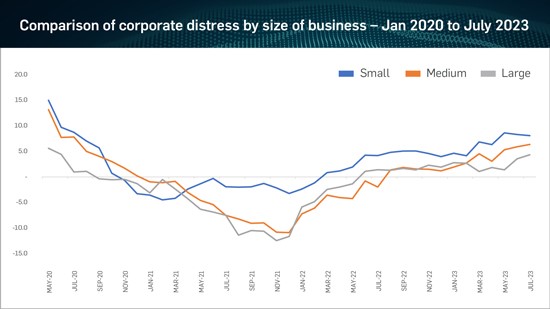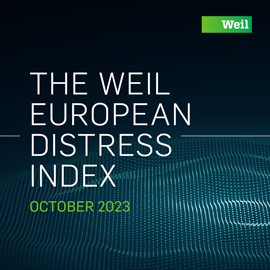October 31, 2023
Corporate distress has risen over the last quarter – particularly across European healthcare firms – according to the latest Weil European Distress Index.
The quarterly study, which aggregates data from more than 3,750 listed corporates and financial market indicators, reveals that shrinking profits, liquidity challenges, and declining investment metrics are all driving this increase. The fading pandemic support, coupled with rising operational costs, and weaker asset prices are also putting pressure on profit margins.
The performance of companies within the overall healthcare sector has been mixed over the past two years. Pharmaceutical companies have seen the greatest rise in share price over this period, but after benefiting from positive tailwinds as investors sought to buy into vaccine makers, they have seen this impact wane considerably. Over the last three months, share prices have fallen by 11.3%, resulting in increased levels of distress.
Whilst the performance of the wider healthcare sector has stabilised since the start of the year, share prices remain considerably lower than two years ago, reflecting a continuing tough backdrop. Uncertainties around the Covid vaccine alongside companies spending their windfalls on ambitious long term plans are weighing on fundamentals, pushing up levels of distress.
More broadly, whilst energy prices have moderated and pressures in supply chains are largely resolved, the outlook is challenging. Rising interest rates are putting disproportionate pressure on highly leveraged firms as debt servicing becomes a higher proportion of earnings.
Market trends
Germany remains Europe’s most distressed market, with levels rising on last year and in the previous quarter. After the economy fell into recession in the first quarter of the year, manufacturing output continues to stutter and the country is continuing to grapple with high energy prices. Consumer spending has been hit by high levels of inflation and German consumers cutting back their spending aggressively.
Corporate distress accelerated in the UK during the last quarter and the country remains Europe’s second most distressed market. Core inflation remains high, and the delayed impact of interest rate hikes is shifting into balance sheets and buying behaviour. According to the Insolvency Service, company insolvencies are at their highest level since 2008.
Corporates headquartered in Spain and Italy also experienced a tightening in levels of distress over the quarter. Although levels are higher than those experienced by French corporates, they remain below those seen in the UK and Germany. The deterioration in conditions were primarily driven by poorer valuations, lacklustre market metrics and weaker investment.
Elsewhere, France was the least distressed country across the latest quarter. However, levels of distress remain above the long-run average for the tenth consecutive month.

Sector trends
Across the industries analysed, Real Estate remains the most distressed sector aside from Healthcare, rising again on levels of last quarter. A combination of rising interest rates, higher debt servicing costs and structural changes in the labour market, causing a fall in demand for office space, is putting intense pressure on the market. In the residential market, rising interest rates are also impacting housing affordability, softening the outlook for house prices.
Retail and consumer remains in the top three with pressure particularly on profitability and liquidity. The impact of rising interest rates has been particularly challenging for many households who have seen housing affordability become more challenging, while falling house prices in the UK and Germany has hit confidence.
Elsewhere, TMT, Infrastructure and Oil and Gas were the least distressed industries across the European markets analysed.





